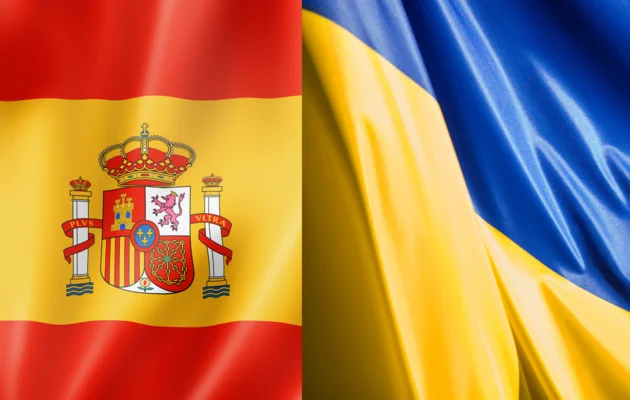Prague is an open-air museum city, because wherever you look, every corner looks magical and romantic. If you plan to go here, then take comfortable shoes, because you will have to walk a lot;) Temples, castles and towers can be safely called the visiting card of Prague, and in the Old Town it is forbidden to build high-rise buildings or install plastic windows, because most of the buildings here are historical monuments.

In order not to get lost in the diversity of beauty, we offer you a list of the most famous and interesting sights in Prague that you should definitely visit.
1. Wenceslas Square
 The central square of the city and one of the most famous in the world. Its length is 750 m, and its width is 60 m. Until 1848, the square was called the Horse Market, as horse fairs were held here in the Middle Ages. There are many shops, cafes, restaurants and hotels. The square is named after Prince Bohemia or St. Wenceslas, the patron saint of the Czech Republic, to whom a monument was erected in 1912 at the beginning of the square. An interesting fact: the buildings on the square are built in such a way that they form numerous passages, that is, walk-through courtyards. Thus, the square is connected to many streets in Prague. All significant events in Prague take place here.
The central square of the city and one of the most famous in the world. Its length is 750 m, and its width is 60 m. Until 1848, the square was called the Horse Market, as horse fairs were held here in the Middle Ages. There are many shops, cafes, restaurants and hotels. The square is named after Prince Bohemia or St. Wenceslas, the patron saint of the Czech Republic, to whom a monument was erected in 1912 at the beginning of the square. An interesting fact: the buildings on the square are built in such a way that they form numerous passages, that is, walk-through courtyards. Thus, the square is connected to many streets in Prague. All significant events in Prague take place here.
2. National Museum
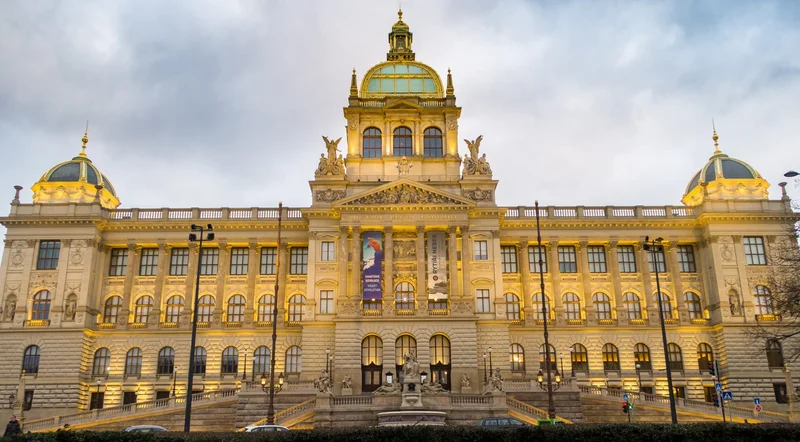 The largest state museum in Prague, which houses many historical artifacts and works of art. The building was built in the neo-Renaissance style, its height is 70 m, and the length of the facade is about 100 m. The museum building was built between 1885 and 1890. In fact, the National Museum consists of several collections, which are located in different places. In the main building on Wenceslas Square, only the Museum of Natural History and History and the Library are located.
The largest state museum in Prague, which houses many historical artifacts and works of art. The building was built in the neo-Renaissance style, its height is 70 m, and the length of the facade is about 100 m. The museum building was built between 1885 and 1890. In fact, the National Museum consists of several collections, which are located in different places. In the main building on Wenceslas Square, only the Museum of Natural History and History and the Library are located.
3. Old Town (or Stare Mesto)
 This is the area of the city where tourists first go when they arrive in Prague. A large number of attractions are concentrated here. The first settlement on this site arose back in the 10th century, and its buildings changed with the change of eras, so architecture lovers will appreciate the atmosphere of old gingerbread houses, Gothic cathedrals, cozy courtyards and doors of old houses that can be looked at forever.
Top Attractions (listed below):
This is the area of the city where tourists first go when they arrive in Prague. A large number of attractions are concentrated here. The first settlement on this site arose back in the 10th century, and its buildings changed with the change of eras, so architecture lovers will appreciate the atmosphere of old gingerbread houses, Gothic cathedrals, cozy courtyards and doors of old houses that can be looked at forever.
Top Attractions (listed below):Community house
Powder Gate
Old Town Square
City Hall
Monument to Jan Hus
Republic Square
4. Republic Square
 The main attraction of the Square is the Public House. Also here you can see the Hibernia Theatre, the Powder Gate, the Powder Tower and visit one of the largest shopping centers in Prague - the Palladium.
The main attraction of the Square is the Public House. Also here you can see the Hibernia Theatre, the Powder Gate, the Powder Tower and visit one of the largest shopping centers in Prague - the Palladium.5. Powder Tower (or Powder Gate)
 Part of the defensive belt that once surrounded Stare Mesto. The tower itself was built in the 15th century and although for many years nothing remained of the fortress walls, the tower was preserved. It survived because King Vladislav II, who ruled in the 15th century, built a palace nearby (now it is the Public House), and the tower was rebuilt, but in the Gothic style. But after the king left the city, the tower was adapted for an ammunition depot. In the 18th century, the tower was shelled many times and was restored only in the 19th century, adding many decorations to the facade, which were not originally there. Interestingly, the tower has preserved an old staircase, which was built in the 16th century and you can climb it (but the entrance is paid). Inside the building there are eastern halls, and a wonderful view of the city opens from the roof.
Part of the defensive belt that once surrounded Stare Mesto. The tower itself was built in the 15th century and although for many years nothing remained of the fortress walls, the tower was preserved. It survived because King Vladislav II, who ruled in the 15th century, built a palace nearby (now it is the Public House), and the tower was rebuilt, but in the Gothic style. But after the king left the city, the tower was adapted for an ammunition depot. In the 18th century, the tower was shelled many times and was restored only in the 19th century, adding many decorations to the facade, which were not originally there. Interestingly, the tower has preserved an old staircase, which was built in the 16th century and you can climb it (but the entrance is paid). Inside the building there are eastern halls, and a wonderful view of the city opens from the roof.
6. Old Town Square
 The heart and center of the Old Town dates back to the 12th century. Prague at that time was at the crossroads of European trade routes and it was on this square that a large market was set up. The tradition of organizing a market in this place has survived to this day. Every winter, one of the largest Christmas markets in the city is destroyed here, and in summer restaurants and cafes set their tables on the square. On this square are the most famous sights of Prague, such as the Town Hall, the Orloj astronomical clock, Church of Our Lady before Týn, the Church of St. Mikulas, the Medieval Pharmacy "House at the Minute", the monument to Jan Hus. The area is pedestrian since the middle of the 20th century.
The heart and center of the Old Town dates back to the 12th century. Prague at that time was at the crossroads of European trade routes and it was on this square that a large market was set up. The tradition of organizing a market in this place has survived to this day. Every winter, one of the largest Christmas markets in the city is destroyed here, and in summer restaurants and cafes set their tables on the square. On this square are the most famous sights of Prague, such as the Town Hall, the Orloj astronomical clock, Church of Our Lady before Týn, the Church of St. Mikulas, the Medieval Pharmacy "House at the Minute", the monument to Jan Hus. The area is pedestrian since the middle of the 20th century.7. Church of Our Lady before Týn
 One of the main symbols of Prague is located on the Old Town Square and dates back to the 14th century. The temple has a large gallery of works in different styles, altarpieces by Karel Škreta, the tombstone of the astronomer Tycho Brahe, and the oldest organ in Prague, isotonic in 1673. The name of the temple comes from the word "tyn" or the fence of the territory. Anyone can get inside, the entrance is conditionally free, but the recommended donation is 25 crowns. On Mondays and Tuesdays, the entrance to the temple is closed.
One of the main symbols of Prague is located on the Old Town Square and dates back to the 14th century. The temple has a large gallery of works in different styles, altarpieces by Karel Škreta, the tombstone of the astronomer Tycho Brahe, and the oldest organ in Prague, isotonic in 1673. The name of the temple comes from the word "tyn" or the fence of the territory. Anyone can get inside, the entrance is conditionally free, but the recommended donation is 25 crowns. On Mondays and Tuesdays, the entrance to the temple is closed.8. Old Town Hall
 This is perhaps the main architectural complex of the Old City. There is a truly fabulous atmosphere here and the Orloi astronomical clock, beloved by tourists, is located. The history of the town hall begins in the 13th century. And over the course of six centuries, the Town Hall was being completed, so it was “assembled” from different architectural styles. You can visit the Town Hall with a guided tour, admission is paid:
for adults - 250 CZK
This is perhaps the main architectural complex of the Old City. There is a truly fabulous atmosphere here and the Orloi astronomical clock, beloved by tourists, is located. The history of the town hall begins in the 13th century. And over the course of six centuries, the Town Hall was being completed, so it was “assembled” from different architectural styles. You can visit the Town Hall with a guided tour, admission is paid:
for adults - 250 CZKfor children and pensioners - 150 CZK.
9. Astronomical clock Orloi
 The astronomical clock or the Prague Astronomical Clock was first mentioned in 1402. But the clock acquired its modern look already in 1948. The central dial shows sidereal time, sunrise and sunset times, lunar phases and of course the time in Central Europe (as well as Old Bohemian and Babylonian). And the bottom dial is a calendar that shows the current date and Christian holidays. This is the oldest astronomical clock still in operation. Each of the four figures on the clock symbolizes a vice: a skeleton - death, a Jew - vanity and greed, a Turk - danger. In addition to these figures, figures of 12 apostles appear on the clock every hour. The performance takes place every hour from 9:00 to 21:00.
The astronomical clock or the Prague Astronomical Clock was first mentioned in 1402. But the clock acquired its modern look already in 1948. The central dial shows sidereal time, sunrise and sunset times, lunar phases and of course the time in Central Europe (as well as Old Bohemian and Babylonian). And the bottom dial is a calendar that shows the current date and Christian holidays. This is the oldest astronomical clock still in operation. Each of the four figures on the clock symbolizes a vice: a skeleton - death, a Jew - vanity and greed, a Turk - danger. In addition to these figures, figures of 12 apostles appear on the clock every hour. The performance takes place every hour from 9:00 to 21:00.10. The House at the Minute
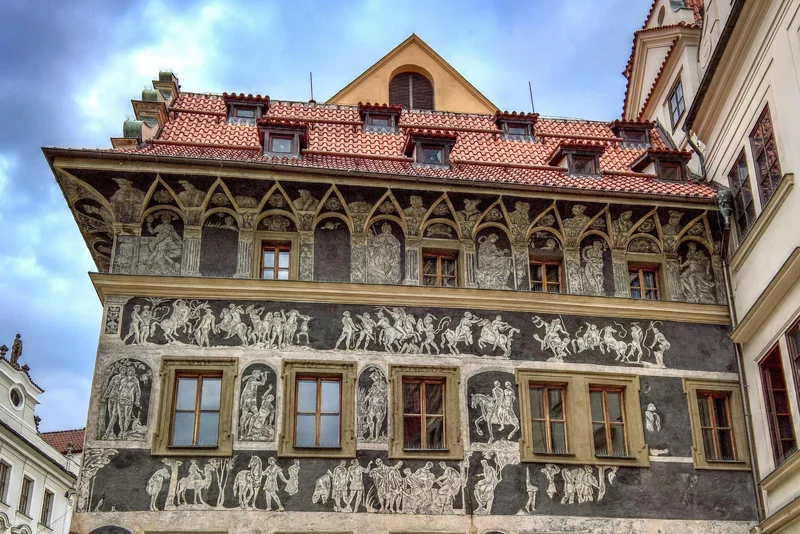 This building is on the left side of the clock tower. The house was built in the 15th century in the late Gothic style. It is an example of Czech Renaissance architecture. What makes it unique is the facade, which is completely covered with murals in the technique of two-color sgraffito. These are frescoes that are made using a stencil. Another interesting fact about the house: the writer Franz Kafka lived here from 6 to 13 years old. The building currently houses a pharmacy.
This building is on the left side of the clock tower. The house was built in the 15th century in the late Gothic style. It is an example of Czech Renaissance architecture. What makes it unique is the facade, which is completely covered with murals in the technique of two-color sgraffito. These are frescoes that are made using a stencil. Another interesting fact about the house: the writer Franz Kafka lived here from 6 to 13 years old. The building currently houses a pharmacy.
11. The Charles Bridge
 Perhaps this is one of the most touristic places in Prague. Therefore, advice right away: if you want to walk along it not in a crowd of tourists, then it is best to do this at dawn. The bridge will connect Stare Mesto and Mala Strana. Built it yet 14th century, and named after Charles IV. There are towers on both sides of the bridge: the Old Town Gothic tower (on the side of the Old Town) and Lesser Town (on the side of the Lesser Town). Both towers have paid viewing platforms. The entire length of the Charles Bridge is decorated with thirty sculptures, most of which were installed between 1683 and 1714, but & nbsp; 20th century transferred to the National Museum. Therefore, now these are copies of the original sculptures.
Perhaps this is one of the most touristic places in Prague. Therefore, advice right away: if you want to walk along it not in a crowd of tourists, then it is best to do this at dawn. The bridge will connect Stare Mesto and Mala Strana. Built it yet 14th century, and named after Charles IV. There are towers on both sides of the bridge: the Old Town Gothic tower (on the side of the Old Town) and Lesser Town (on the side of the Lesser Town). Both towers have paid viewing platforms. The entire length of the Charles Bridge is decorated with thirty sculptures, most of which were installed between 1683 and 1714, but & nbsp; 20th century transferred to the National Museum. Therefore, now these are copies of the original sculptures.12. Prague Venice (Kampa Island)
 This place is located near the Charles Bridge. The island was formed in the 12th century by artificial means (at that time monks lived on the island). The monks had several mills, for the maintenance of which an artificial channel was dug, which separates the island from Malaya Strana. Kampa is washed by the rivers Vltava and Chertovka. Excursion boats built in the style of the 19th century go along the canal all year round.
This place is located near the Charles Bridge. The island was formed in the 12th century by artificial means (at that time monks lived on the island). The monks had several mills, for the maintenance of which an artificial channel was dug, which separates the island from Malaya Strana. Kampa is washed by the rivers Vltava and Chertovka. Excursion boats built in the style of the 19th century go along the canal all year round.
13. The narrowest street in Prague
 On the island of Kampa there is the narrowest street in Prague. Its width is only 70 cm. In fact, it is a marketing ploy of the Vinarna Certovka restaurant. This street goes just to him. The street is so narrow that only one person can walk there at a time. Therefore, a traffic light is installed at the entrance to it.
On the island of Kampa there is the narrowest street in Prague. Its width is only 70 cm. In fact, it is a marketing ploy of the Vinarna Certovka restaurant. This street goes just to him. The street is so narrow that only one person can walk there at a time. Therefore, a traffic light is installed at the entrance to it.
14. Wallenstein Palace
 The largest palace in Prague. Built in early baroque style between 1623 and 1630. A palace was created for the generalissimo of the empire, admiral of the fleet Albrecht Wallenstein, who personally supervised the implementation of the project. Inside the palace, tourists are most interested in the Knights' Hall, which occupies two floors, and in which there is an image of Wallenstein in the form of the god of war - Mars. After Wallenstein's death, the palace was initially confiscated by the city, but then returned to the customer's nephew, in whose possession it remained until the end of World War II. Today it is the seat of the Senate of the Czech Republic. During the summer, the palace garden is open to visitors.
The largest palace in Prague. Built in early baroque style between 1623 and 1630. A palace was created for the generalissimo of the empire, admiral of the fleet Albrecht Wallenstein, who personally supervised the implementation of the project. Inside the palace, tourists are most interested in the Knights' Hall, which occupies two floors, and in which there is an image of Wallenstein in the form of the god of war - Mars. After Wallenstein's death, the palace was initially confiscated by the city, but then returned to the customer's nephew, in whose possession it remained until the end of World War II. Today it is the seat of the Senate of the Czech Republic. During the summer, the palace garden is open to visitors.
15. Prague Castle
 This is the largest castle complex in the world and is located on the left bank of the Vltava. There are two ways to get here: through the Front Gate (from the side of Hradchanskaya Square) and through the opposite gate - the Black Tower. For security purposes, there are guards at two entrances and check things. It is a complex of buildings, temples and fortifications. Today the fortress is the residence of the President of the Czech Republic, and earlier the Czech kings lived here. It is important to note that the entrance to the territory of the fortress is free, but there are separate places where you need an entrance ticket, you can find out all the information at the entrance to the information desk. The main architectural dominant is St. Vitus Cathedral. Also, from the sights, pay attention to: Teresian Palace, Chapel of the Holy Cross, fountains, Powder Bridge, Picture Gallery of Prague Castle, Zlata Lane, Monastery of St. George.
This is the largest castle complex in the world and is located on the left bank of the Vltava. There are two ways to get here: through the Front Gate (from the side of Hradchanskaya Square) and through the opposite gate - the Black Tower. For security purposes, there are guards at two entrances and check things. It is a complex of buildings, temples and fortifications. Today the fortress is the residence of the President of the Czech Republic, and earlier the Czech kings lived here. It is important to note that the entrance to the territory of the fortress is free, but there are separate places where you need an entrance ticket, you can find out all the information at the entrance to the information desk. The main architectural dominant is St. Vitus Cathedral. Also, from the sights, pay attention to: Teresian Palace, Chapel of the Holy Cross, fountains, Powder Bridge, Picture Gallery of Prague Castle, Zlata Lane, Monastery of St. George.
16. St. Vitus Cathedral
 This main architectural landmark of Prague Castle is located in its very center. The history of the cathedral began in 1344, and it was built for almost six centuries and combined elements of many styles. Many well-known architects from the Czech Republic, France, Germany had a hand in this magnificent cathedral. And it was decorated by the Czech artist Alfons Mucha.
This main architectural landmark of Prague Castle is located in its very center. The history of the cathedral began in 1344, and it was built for almost six centuries and combined elements of many styles. Many well-known architects from the Czech Republic, France, Germany had a hand in this magnificent cathedral. And it was decorated by the Czech artist Alfons Mucha.
Today St. Vitus Cathedral serves as the residence of the Archbishop of Prague. Entrance to the cathedral is free.
17. Golden Lane
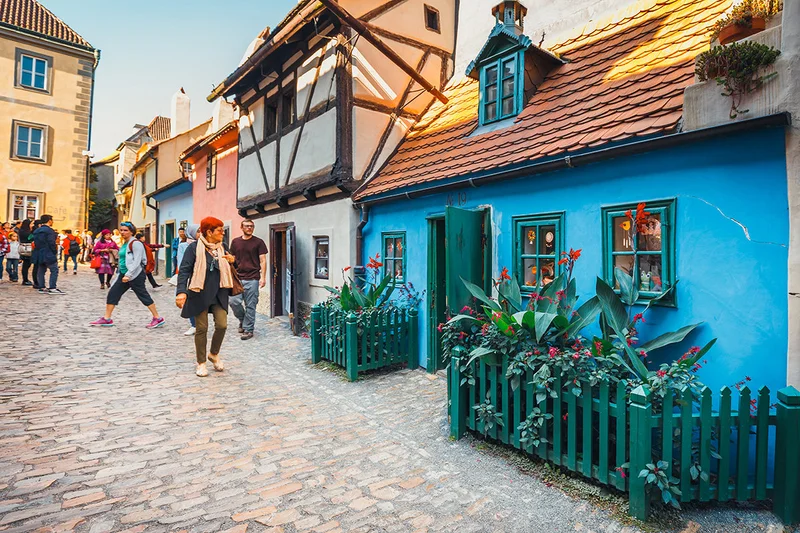 This is another attraction of the Prague Castle. It is located between the White Tower and Daliborka and is a “handicraft” street from a complex of small colored houses of a fabulous look. The history of the street begins in the 16th century, when members of the guard service lived here. But soon the street turned into a craftsman's street and became a congestion of the poor. And in the house number 22 in the period from 1916 to 1917, Franz Kafka worked. After the Second World War, the houses were no longer used for housing. Today, this street is part of the Prague Castle sightseeing route and consists of 16 houses with souvenir shops and expositions that show tourists the life of the Red Riflemen (the oldest population of the street), workshops of goldsmiths, there is also a tavern and a herbalist's house. There is a house where you can see the household of a fortune-teller and clairvoyant Matilda Prusova, who was quite famous in her time in Prague. On the western side of the street there is a tower, the lower part of which served as a prison (the alchemist Edward Kelly was imprisoned here). The prison was here until the middle of the 18th century.
It is important to note that the entrance to the street is paid (there is no separate ticket, only a comprehensive excursion). But after the closing of all souvenir shops and houses, the street is available for free viewing.
This is another attraction of the Prague Castle. It is located between the White Tower and Daliborka and is a “handicraft” street from a complex of small colored houses of a fabulous look. The history of the street begins in the 16th century, when members of the guard service lived here. But soon the street turned into a craftsman's street and became a congestion of the poor. And in the house number 22 in the period from 1916 to 1917, Franz Kafka worked. After the Second World War, the houses were no longer used for housing. Today, this street is part of the Prague Castle sightseeing route and consists of 16 houses with souvenir shops and expositions that show tourists the life of the Red Riflemen (the oldest population of the street), workshops of goldsmiths, there is also a tavern and a herbalist's house. There is a house where you can see the household of a fortune-teller and clairvoyant Matilda Prusova, who was quite famous in her time in Prague. On the western side of the street there is a tower, the lower part of which served as a prison (the alchemist Edward Kelly was imprisoned here). The prison was here until the middle of the 18th century.
It is important to note that the entrance to the street is paid (there is no separate ticket, only a comprehensive excursion). But after the closing of all souvenir shops and houses, the street is available for free viewing.18. New World street
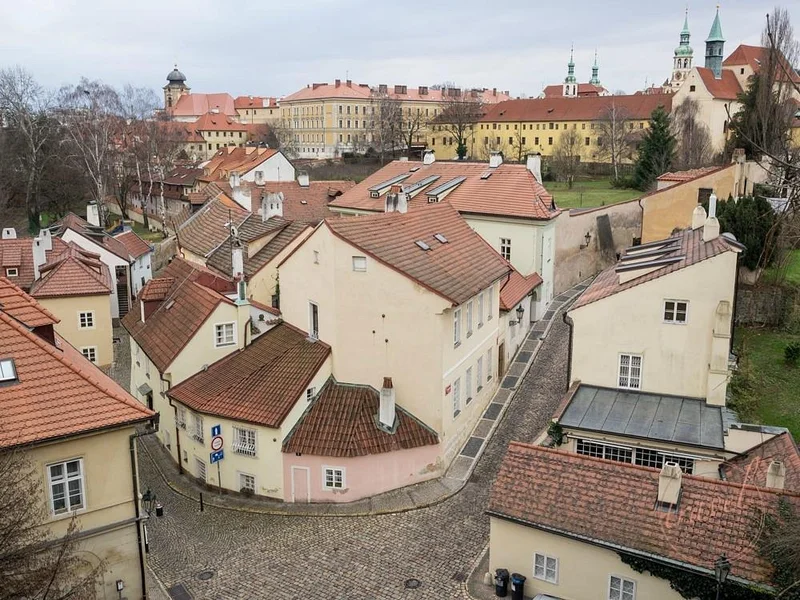 New Set is a small cozy street where you can see how Parisian streets looked like in the old days. Initially, servants and craftsmen from Prague Castle settled here, and later the street became a favorite place for artists, poets and romantics. The street consists of small cozy houses of various shapes and with bright tiled roofs. The construction of the street began in the 14th century and it still retains its medieval flavor. Well, the street was constantly on fire and it was rebuilt more than once. The last rebuilding was in the 17th century.
New Set is a small cozy street where you can see how Parisian streets looked like in the old days. Initially, servants and craftsmen from Prague Castle settled here, and later the street became a favorite place for artists, poets and romantics. The street consists of small cozy houses of various shapes and with bright tiled roofs. The construction of the street began in the 14th century and it still retains its medieval flavor. Well, the street was constantly on fire and it was rebuilt more than once. The last rebuilding was in the 17th century.
19. Visegrad

This is the oldest district of Prague, located on the banks of the Vltava. It is a fortress of the 10th century, located on a hill and it is the former residence of the first Czech dukes. In addition to the sights of the fortress itself, a delightful panoramic view of Prague opens from above.
Attractions of Visegrad:
Church of Saints Peter and Paul
Watchtower ruins
Memorial cemetery
Sculptures of ancient Czech heroes
Visegrad Museum
Rotunda of St. Martin
Leopold's gate
Observation deck with views of Prague
20. The dancing house
 The dancing house, or, as it is often called, the drunken house, was built 20 years ago on the initiative of the then President of the Czech Republic & nbsp; Vaclav Havel. It consists of two towers: one is straight, and the second is curved. Often they are compared with a dancing couple, where the straight tower is a man, and the curved one is a woman. It was built on the ruins of a house that was damaged during the bombing. The Dancing House is an office center, inside there is also a modern gallery and a restaurant, and from the roof you can see the center of Prague.
The dancing house, or, as it is often called, the drunken house, was built 20 years ago on the initiative of the then President of the Czech Republic & nbsp; Vaclav Havel. It consists of two towers: one is straight, and the second is curved. Often they are compared with a dancing couple, where the straight tower is a man, and the curved one is a woman. It was built on the ruins of a house that was damaged during the bombing. The Dancing House is an office center, inside there is also a modern gallery and a restaurant, and from the roof you can see the center of Prague.
21. Jewish synagogues
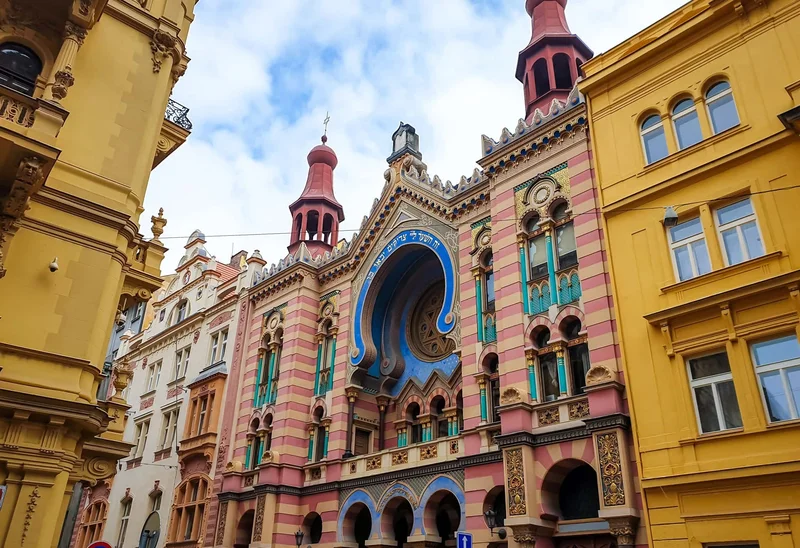 One of the places worth seeing in Prague is the Jewish Quarter (called Josefov). Kartal has been known since the 13th century, when Jews were forbidden to live anywhere else. The ghetto had its own schools, town hall, cemetery and, of course, synagogues. And since the time of the Jewish ghetto, many unique buildings have been preserved here. The most popular synagogue is Staronovaya, which was built in the 13th century. There are also: Pinkas Synagogue (the second oldest synagogue in the city, construction was completed in 1535), Maisel Synagogue (built in the 16th century), High Synagogue (built in the 17th century), Klaus Synagogue (built in 1694 on the site of the Talmud destroyed by fire schools, synagogues and hospitals, which because of their small size were called klaus.The new synagogue is already many times larger, but retained its name), the Spanish Synagogue in the Arab-Moorish style (built in 1868).
One of the places worth seeing in Prague is the Jewish Quarter (called Josefov). Kartal has been known since the 13th century, when Jews were forbidden to live anywhere else. The ghetto had its own schools, town hall, cemetery and, of course, synagogues. And since the time of the Jewish ghetto, many unique buildings have been preserved here. The most popular synagogue is Staronovaya, which was built in the 13th century. There are also: Pinkas Synagogue (the second oldest synagogue in the city, construction was completed in 1535), Maisel Synagogue (built in the 16th century), High Synagogue (built in the 17th century), Klaus Synagogue (built in 1694 on the site of the Talmud destroyed by fire schools, synagogues and hospitals, which because of their small size were called klaus.The new synagogue is already many times larger, but retained its name), the Spanish Synagogue in the Arab-Moorish style (built in 1868).
22. Clementinum and the National Library of the Czech Republic
 Clementinum is a complex of buildings of the former Jesuit Collegium, which today is occupied by the National Library of the Czech Republic. It is located in the Prague quarter of Stare Mesto, near the Charles Bridge. Initially, a Dominican monastery was located on the site of the complex. The Jesuit Collegium arose in 1552, and by the 17th century it had become one of the largest Jesuit training centers in the world. In 1773 the order was abolished and reorganized into an educational and library center.
The complex of buildings of Clementinum includes a number of buildings:
Clementinum is a complex of buildings of the former Jesuit Collegium, which today is occupied by the National Library of the Czech Republic. It is located in the Prague quarter of Stare Mesto, near the Charles Bridge. Initially, a Dominican monastery was located on the site of the complex. The Jesuit Collegium arose in 1552, and by the 17th century it had become one of the largest Jesuit training centers in the world. In 1773 the order was abolished and reorganized into an educational and library center.
The complex of buildings of Clementinum includes a number of buildings:astronomical observatory: its height is 68 m, there is an exposition of ancient astronomical instruments and documentary materials about the tower itself;
Mirror Chapel: located on the first floor of the wing that connects the Astronomical Tower with the northern wing of the collegium, on the street. Planetary. It got its name because of the abundance of mirrors located on the walls.
university library: thousands of valuable books on theology are stored here,
mathematical museum,
the first weather station in Central Europe: it was here that the scientist Kepler discovered the laws of planetary motion.
23. Hradchany

This is one of the districts of Prague, which is located on the western side of the Prague Castle. Was founded in early 14th century as an area for grooms, servants, and so on. And only from the middle of the 16th century (after all the houses burned down and were rebuilt again), the houses began to be populated by representatives of the nobility. Attractions in Hradcany:
Loreta (or Loretan Monastery);
Church of the Nativity;
Old Town Hall;
Church of St. Benedict
Strahov Monastery
24. Prague Loreta
 It is a complex of historical baroque buildings on the eastern side of Loretan Square in Hradcany and a place of pilgrimage for many Christians. It includes:
It is a complex of historical baroque buildings on the eastern side of Loretan Square in Hradcany and a place of pilgrimage for many Christians. It includes:Chapel of St. Anna
Chapel of St. Francis of Padua
Chapel of St. Joseph
Chapel of St. Cross
Chapel of Anthony of Padua
Chapel of Our Lady of Sorrows
Church of the Nativity
Fountain with a sculptural group of the Assumption of the Virgin Mary
Fountain with a sculptural group of the Resurrection of the Lord
Holy Hut of Our Lady of Loreto
It is worth paying attention to the bells, which every hour sing the hymn to the Virgin. The Loreto treasury will also be of interest (the church utensils donated by the founders of the complex in the 17th century are stored here). It is worth noting that the entrance ticket to the complex is paid.
25. Strahov Monastery

This is an architectural monument of the Czech Republic of the first half of the 12th century. It is famous for its library, once it was the largest in the Czech Republic. It was built for Premonstratensian monks. The monastery is also famous for its collection of paintings, which began to be collected in the 18th century. And also, we want to note that the monastery has its own restaurant and brewery.
26. Petrin Hill

The hill is located on the left bank of the Vltava and in order to climb the hill you will have to overcome 299 steps. And those who do not like to climb on foot can use the funicular (it is paid :) But in any case, you will not regret it, because at the top there is a stunning view of the city, and other attractions are also available:
- Petrin Tower (copy of the Eiffel Tower)
- Observation deck overlooking the city
- Mirror Maze
- Church of St. Lawrence built in 922.
- Stefanik Observatory (founded 1928)
- Rosary with over 10,000 roses
27. Petrin Tower
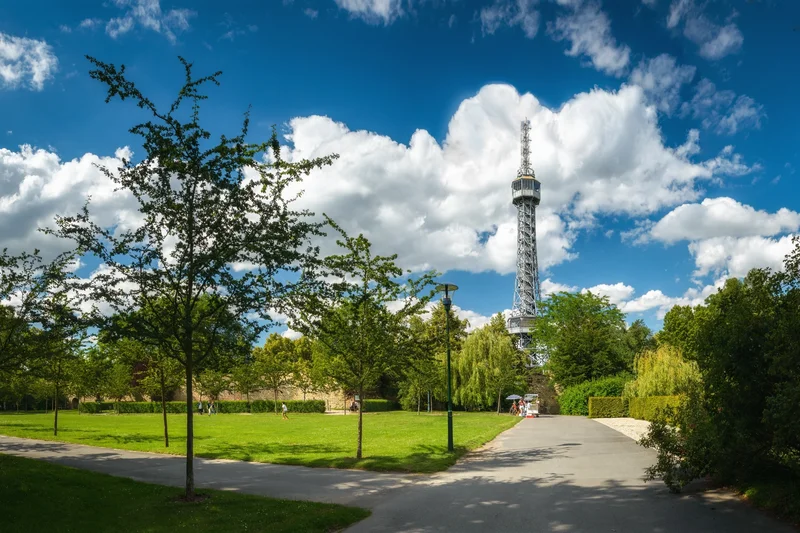
The height of the tower is 216 meters and it is considered a copy of the Eiffel. It can be seen from almost anywhere in the city. There is a functioning television center, an observation deck, an exhibition of paintings and a restaurant with a hotel. The entrance to the tower is paid.
28. Singing Krzhizhikov fountains

Fountains are located near the Prague East Center. They were built in 1891 (but in 1991 they were completely reconstructed). Here you will see a light show accompanied by music. And more recently, dancers have also been added to the performance. It should be noted that the entrance to the performance is paid.
Public transport in Prague

Prague's urban public transport consists of metro networks, buses and trams. Also in Prague there is a funicular that rises to the Petrshinsky hill and ferry crossings across the Vltava. In addition, Prague has a small cable car and one trolleybus line.
Tariff zones
Prague is within zones P, 0 and B, while suburban zones are numbered from 1 to 9
If you need to move only within Prague, then the zones are considered equal and tickets are purchased at a fixed price (regardless of the purpose of the trip). Tariff zoning of payment is relevant only for trips between Prague and the suburbs.
Price Fares in Prague in 2023:
There are three metro lines in Prague:
Line A (Green): Depo Hostivař – Nemocnice Motol
Line B (Yellow):Černý Most – Zličín
Line С (red): Letňany – Háje
Interval between trains: 2-4 minutes.
Trams
The intervals between trams during rush hour are 8-10 minutes, at normal times 10-20 minutes.
Buses
Traffic intervals: during rush hour 6-8 minutes, during normal times 15-30 minutes.
Public transport at night
The night schedule is valid from 0:30 to 4:30. Basically, transportation at night is carried out by 9 tram lines (No. 91-99) with an interval of 30 minutes. Also, according to the night schedule, buses No. 901-915 run at intervals of 30 minutes.
Where to eat in Prague
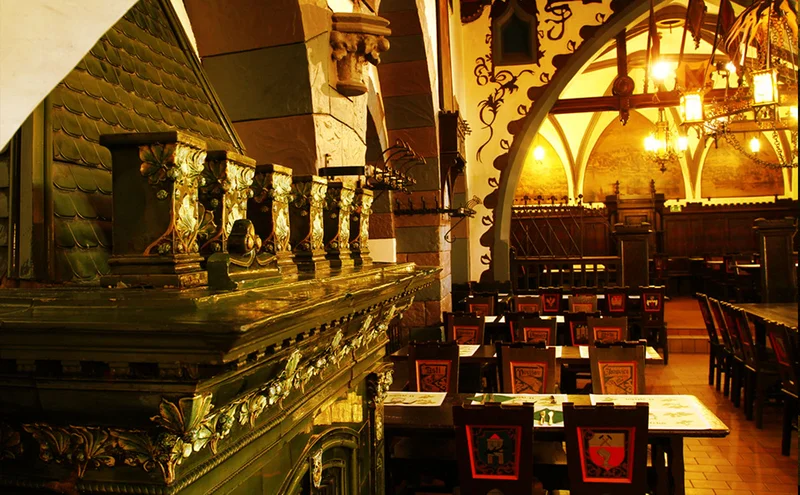 U Fleků
One of the most famous restaurants in Prague. It serves classic Czech cuisine and, of course, beer.
Address: Křemencova 11, 110 00 Nove mesto
Pivovarsky dum
It has its own mini-brewery where you can taste live, fresh Czech beer.
Address: Ječná 511/16, 120 44 Nove Mesto
U Fleků
One of the most famous restaurants in Prague. It serves classic Czech cuisine and, of course, beer.
Address: Křemencova 11, 110 00 Nove mesto
Pivovarsky dum
It has its own mini-brewery where you can taste live, fresh Czech beer.
Address: Ječná 511/16, 120 44 Nove MestoMistral Café Classic breakfasts, lunches and dinners are served. The atmosphere of modern Provence reigns in the cafe.
Address: 56, Valentinská 11, Staré Město, 110 00 Prague 1 La Bohéme Café The cafe specializes in coffee (here you can try coffee from American, African and Asian plantations).
Address: Sázavská 2031/32, 120 00 Vinohrady
Café Savoy One of the most popular cafes in Prague among both tourists and locals. Poilane bread and Savoy cake are specialties here. For lunch and dinner you can taste traditional Czech dishes. Address: Vítězná 124/5, Prague 5 Café Colore The menu is very varied, you can taste the cuisine of different countries. They also serve homemade desserts and cakes. Address: Palackého 740/1, Prague 1 Café Prádelna The cafe is famous for its design, which in some places resembles a laundry (it's not just that, because "prádelna" is Czech for laundry. But the cafe is also famous for its homemade desserts and ice cream. Be sure to try the seasonal homemade ice cream (for example, plum with cardamom and star anise). Address: Slavíkova 21, Prague 2
Things to Do in Prague
Prague Zoo
 He walks in the top ten best zoos in the world. Located in a picturesque park, more than 4 thousand animals of 645 species live here.
Address: U Trojského zámku 120/3, Praha 7
Working hours:
January, February: 9:00-16:00
March: 9:00-17:00
April, May: 9:00-18:00
June, July, August: 9:00-21:00
September, October: 9:00-18:00
November, December: 9:00-16:00
December 24 and 31: 9:00-14:00
He walks in the top ten best zoos in the world. Located in a picturesque park, more than 4 thousand animals of 645 species live here.
Address: U Trojského zámku 120/3, Praha 7
Working hours:
January, February: 9:00-16:00
March: 9:00-17:00
April, May: 9:00-18:00
June, July, August: 9:00-21:00
September, October: 9:00-18:00
November, December: 9:00-16:00
December 24 and 31: 9:00-14:00
Prague Oceanarium
 The aquarium is home to about 350 species of aquatic life: from juveniles to crocodiles and sharks. In the center there is an open aquarium, the inhabitants of which can be fed (buying food at the entrance).
Address: Výstaviště, Praha 7 – Holešovice
Working hours:
Mon-Fri: 8:30-18:00
Sat-Sun: 9:00-19:00
The aquarium is home to about 350 species of aquatic life: from juveniles to crocodiles and sharks. In the center there is an open aquarium, the inhabitants of which can be fed (buying food at the entrance).
Address: Výstaviště, Praha 7 – Holešovice
Working hours:
Mon-Fri: 8:30-18:00
Sat-Sun: 9:00-19:00
Amusement park Majaland Praha
 The largest indoor amusement park in the country. Located in the shopping center POP Airport.
Address: POP Airport, Ke Kopanině 421, 252 67 Tuchoměřice
Working hours: daily from 10:00 to 20:00
The largest indoor amusement park in the country. Located in the shopping center POP Airport.
Address: POP Airport, Ke Kopanině 421, 252 67 Tuchoměřice
Working hours: daily from 10:00 to 20:00
Prague Planetarium
 It belongs to one of the largest in the world. The diameter of its dome is 23.5 m.
Address: Královská obora 233 Praha 7, 170 21
Working hours:
January, February: Tue-Fri 18:00-20:00; Sat-Sun 11:00-20:00
March: Tue-Fri 19:00-21:00; Sat-Sun 11:00-18:00, 19:00-21:00
April, May: Tue-Fri 15:00-19:00, 21:00-23:00; Sat-Sun 11:00-19:00, 21:00-23:00
June: Mon-Fri: 15:00-19:00, 21:00-23:00; Sat-Sun: 10:00-19:00, 21:00-23:00
July, August: Mon-Fri: 11:00-19:00, 21:00-23:00; Sat-Sun 11:00-19:00, 21:00-23:00
September: Mon-Fri 15:00-18:00, 20:00-22:00; Sat-Sun 10:00-18:00, 20:00-22:00
October: Tue-Fri 19:00-21:00; Sat-Sun 10:00-18:00, 19:00-21:00
It belongs to one of the largest in the world. The diameter of its dome is 23.5 m.
Address: Královská obora 233 Praha 7, 170 21
Working hours:
January, February: Tue-Fri 18:00-20:00; Sat-Sun 11:00-20:00
March: Tue-Fri 19:00-21:00; Sat-Sun 11:00-18:00, 19:00-21:00
April, May: Tue-Fri 15:00-19:00, 21:00-23:00; Sat-Sun 11:00-19:00, 21:00-23:00
June: Mon-Fri: 15:00-19:00, 21:00-23:00; Sat-Sun: 10:00-19:00, 21:00-23:00
July, August: Mon-Fri: 11:00-19:00, 21:00-23:00; Sat-Sun 11:00-19:00, 21:00-23:00
September: Mon-Fri 15:00-18:00, 20:00-22:00; Sat-Sun 10:00-18:00, 20:00-22:00
October: Tue-Fri 19:00-21:00; Sat-Sun 10:00-18:00, 19:00-21:00November, December: Tue-Fri 18:00-20:00
Boat trip on the Vltava
 There are a lot of offers, choose a boat and time and go for an introductory walk along the embankment. The views are beautiful at any time of the year.
There are a lot of offers, choose a boat and time and go for an introductory walk along the embankment. The views are beautiful at any time of the year.
Mirror labyrinth at Petriny
 This “attraction” is located on Petrin Hill and was built in 1891. In the central hall there is a diorama with a battle on the Charles Bridge. You won’t get lost there, so you can safely take the children with you. After passing the labyrinth itself, you can go through & nbsp; another room with crooked mirrors :)
Address: Bludiště na Petříně, Petřínské sady, Prague 1
Working hours:
October – March: 10.00 – 18.00
April – May: 09.00 – 19.00
June – August: 09.00 – 20.00
September: 09.00 – 19.00
This “attraction” is located on Petrin Hill and was built in 1891. In the central hall there is a diorama with a battle on the Charles Bridge. You won’t get lost there, so you can safely take the children with you. After passing the labyrinth itself, you can go through & nbsp; another room with crooked mirrors :)
Address: Bludiště na Petříně, Petřínské sady, Prague 1
Working hours:
October – March: 10.00 – 18.00
April – May: 09.00 – 19.00
June – August: 09.00 – 20.00
September: 09.00 – 19.00
Museums in Prague
Chocolate Museum
If you are a chocolate lover and do not know what to do with yourself, then this place is just for you. On the way you will be treated to a chocolate bar (or a cup of hot chocolate), and In the museum itself, you will learn about the history of chocolate and will be able to view a collection of different wrappers and packaging for chocolate.
Address: Celetná 10, Prague 1, Czech Republic
Working hours: from 09:30 to 19:00.
 It will be interesting for both children and adults. In the museum you can see the models of the designer from the oldest to the newest.
Address: Národní 31, 110 00 Praha 1 – Nové Město
Working hours: from 10:00 to 20:00.
National Technical Museum
It will be interesting for both children and adults. In the museum you can see the models of the designer from the oldest to the newest.
Address: Národní 31, 110 00 Praha 1 – Nové Město
Working hours: from 10:00 to 20:00.
National Technical Museum
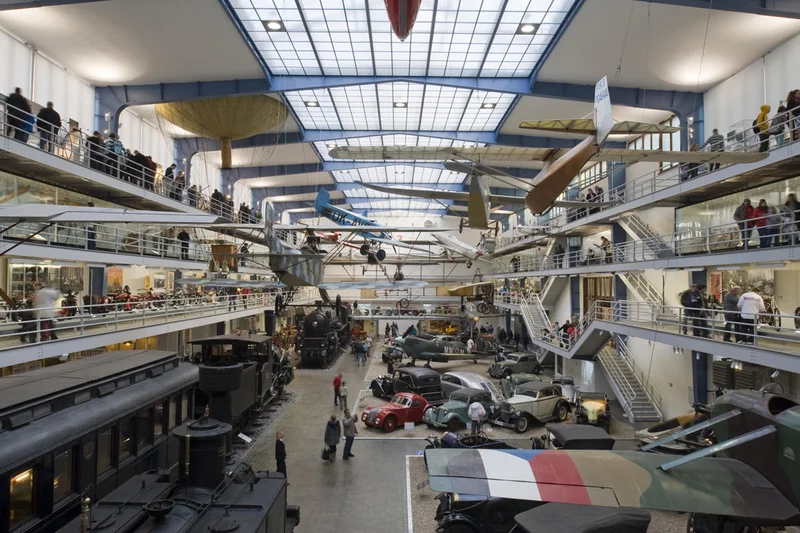 The museum is dedicated to the development of technology (watches, cameras, film production, automotive, etc.)
Address: Kostelní 42.
Working hours: from Tuesday to Sunday from 9:00 to 17:00.
Museum of Communism
The museum is dedicated to the development of technology (watches, cameras, film production, automotive, etc.)
Address: Kostelní 42.
Working hours: from Tuesday to Sunday from 9:00 to 17:00.
Museum of Communism
 Address: V Celnici 1031/4, Nové Město
Working hours: daily from 9:00 to 20:00, except Christmas holidays.
Czech Beer Museum
Address: V Celnici 1031/4, Nové Město
Working hours: daily from 9:00 to 20:00, except Christmas holidays.
Czech Beer Museum
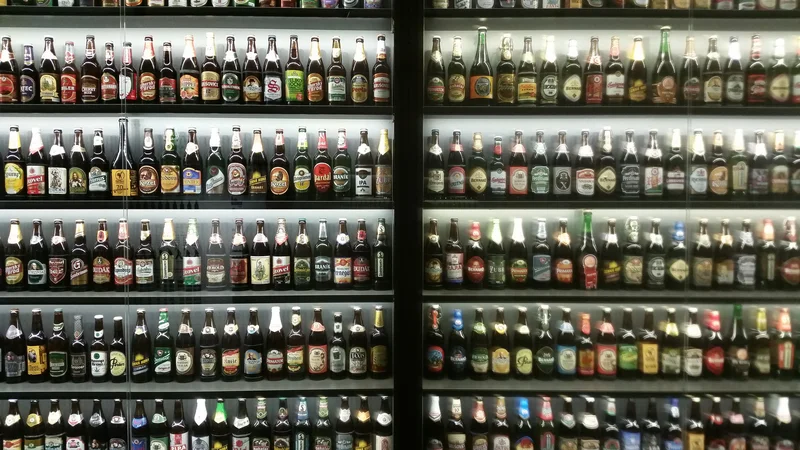 The name of the museum speaks for itself :) Here you will get acquainted with the history and try several varieties of local beer.
Address: Husova 241/7, Staré Město.
Working hours: daily from 12:00 to 18:00.
Torture Museum
The name of the museum speaks for itself :) Here you will get acquainted with the history and try several varieties of local beer.
Address: Husova 241/7, Staré Město.
Working hours: daily from 12:00 to 18:00.
Torture Museum
 Here you can get acquainted with the tools used by European inquisitors until the 17th century.
Address: Celetná 558, Staré Město
Working hours: daily from 10:00 to 20:00.
Museum of Alchemy
Here you can get acquainted with the tools used by European inquisitors until the 17th century.
Address: Celetná 558, Staré Město
Working hours: daily from 10:00 to 20:00.
Museum of Alchemy
 Prague is famous for its alchemists, "scientists" from all over Europe came here to conduct their experiments. In addition to the main collection, which tells the history of alchemy in the Czech Republic, they also sell various tinctures (based on natural herbs): & nbsp; elixir of memory, love, youth, etc.
Address: Haštalská 1, Staré Město.
Working hours: the museum is open daily from 10:00 to 18:00, seven days a week.
Museum of Sex Devices
Prague is famous for its alchemists, "scientists" from all over Europe came here to conduct their experiments. In addition to the main collection, which tells the history of alchemy in the Czech Republic, they also sell various tinctures (based on natural herbs): & nbsp; elixir of memory, love, youth, etc.
Address: Haštalská 1, Staré Město.
Working hours: the museum is open daily from 10:00 to 18:00, seven days a week.
Museum of Sex Devices
 The museum occupies three floors of a historical building in the center of Prague (so you definitely won't be bored). The collection contains a variety of devices, the purpose of which is to bring pleasure to a person;) Here you can see sex toys from the middle to the present day.
Address: Melantrichova 476/18, Staré Město
Working hours: daily from 10:00 to 23:00, seven days a week.
Museum of Miniatures
The museum occupies three floors of a historical building in the center of Prague (so you definitely won't be bored). The collection contains a variety of devices, the purpose of which is to bring pleasure to a person;) Here you can see sex toys from the middle to the present day.
Address: Melantrichova 476/18, Staré Město
Working hours: daily from 10:00 to 23:00, seven days a week.
Museum of Miniatures
 The museum presents 40 miniature works by Anatoly Kononenko. You can only see them through a magnifying glass. For example, you can see a mosquito with the Eiffel Tower on a leg or a caravan of camels in the eye of a needle.
Address: Strahovské nádvoří 11, Praha 1
Working hours: from 10:00 to 17:00.
The Wax Museum
The museum presents 40 miniature works by Anatoly Kononenko. You can only see them through a magnifying glass. For example, you can see a mosquito with the Eiffel Tower on a leg or a caravan of camels in the eye of a needle.
Address: Strahovské nádvoří 11, Praha 1
Working hours: from 10:00 to 17:00.
The Wax Museum
 The museum is divided into several zones. So, in the creative hall you can see Franz Kafka, Karl Chapek, Salvador Dali, Charlie Chaplin, Alphonse Mucha and other people from the art world. And in the modern art hall, you will meet Michael Jackson, Freddie Mercury, Louis Armstrong, Mick Jagger and others. There is also a hall with political figures such as Princess Diana, Adolf Hitler, Vladimir Lenin, Gustav Husak and others.
Address: Celetná 10, Praha 1
Working hours: from 10:00 to 21:00
The museum is divided into several zones. So, in the creative hall you can see Franz Kafka, Karl Chapek, Salvador Dali, Charlie Chaplin, Alphonse Mucha and other people from the art world. And in the modern art hall, you will meet Michael Jackson, Freddie Mercury, Louis Armstrong, Mick Jagger and others. There is also a hall with political figures such as Princess Diana, Adolf Hitler, Vladimir Lenin, Gustav Husak and others.
Address: Celetná 10, Praha 1
Working hours: from 10:00 to 21:00


